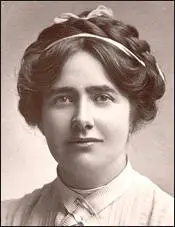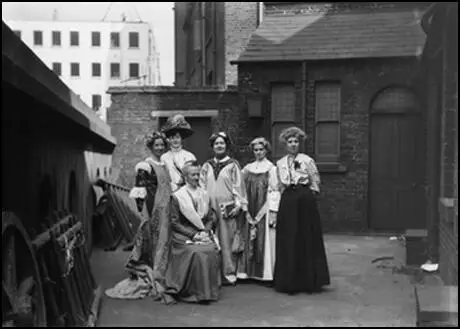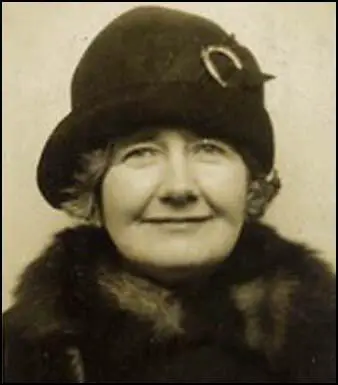Teresa Billington-Greig

Teresa Billington, the daughter of a shipping clerk, was born in Blackburn, Lancashire, in 1877. Teresa had a stormy relationship with her parents. There was constant conflict concerning her disagreement with her parents' strong Roman Catholic views. She later said of her education: "We were taught to be Catholic young ladies on the lines of the education given to our grandmothers. There were no oral lessons, no demonstrations, no analysis or breaking down of problems. We sat quietly in rows of desks, learned from books, and our work was corrected by the nun who was mistress of the moment from the answers at the back of a similar book." Teresa ran away from home as a teenager and for the rest of her life was an outspoken agnostic.
Teresa became a pupil-teacher and eventually found work as a schoolteacher in Crumpsall. A fellow member of staff was Alice Schofield. However, Teresa's refused to teach religious instruction and this led to the Manchester Education Committee threatening to sack her. Emmeline Pankhurst, a member of the Manchester Education Committee, was impressed by Teresa's spirit and arranged for her to be transferred to a Jewish school where she would not have to teach religion.
With Emmeline Pankhurst's encouragement, Teresa Billington became a member of the Independent Labour Party in Manchester. In 1904 she was appointed as the organiser of the party in the city. Teresa also became involved in trade union issues. She objected to the fact that men received higher wages than women and became secretary of the Manchester Equal Pay Committee. During this period she became friendly with Eva Gore-Booth and Esther Roper.
In 1905 she was asked by Emmeline Pankhurst and James Keir Hardie to become a full-time organiser for the Independent Labour Party. She was only the second to be appointed and the first woman to hold such an appointment. Teresa later explained: "I gave up my teaching, my Equal Pay League work and my activity at the Manchester University Settlement and sacrificed my chance of a science degree to forward the woman's cause through the ILP." She was a great success at her new job. Elizabeth Wolstenholme-Elmy said: "It is to Miss Billington, more than to any other person or persons that the great labour parliamentary victories in the Potteries are due."

Teresa joined the Women's Social and Political Union and in 1907 she was asked to become a full-time worker for the organisation in London with Annie Kenney. Within a few months of arriving, Teresa had been arrested and sent to Holloway Prison. That year she also married a socialist, Frederick Lewis Greig (1875-1961), who worked as a manager for a billiard table manufacturer. He was sympathetic to women's rights and agreed to adopt Billington-Greig as their joint name.
Teresa, like other suffrages at the time, questioned the way that Emmeline Pankhurst and Christabel Pankhurst were running the WSPU. She objected to the way they made decisions without consulting members. Teresa also felt that a small group of wealthy women were beginning to dominate the organisation and in 1907 she left the WSPU with Charlotte Despard and Alice Schofield to form the Women's Freedom League.
Teresa Billington-Greig also came into conflict with Margaret Bondfield over the issue of adult suffrage. Billington-Greig argued that women's political organisations should be advocating the "immediate granting of the Parliamentary Franchise to women on the same terms as men in the speediest and most practical way to real democracy". Bondfield took the view that if this happened the Conservatives would gain an advantage over the Labour Party. Bondfield also feared that once middle-class women had the vote, many of the leaders of the WSPU and NUWSS would lose interest in fighting for the political rights of working-class women. In December 1907, a public debate took place between Billington-Greig and Bondfield on this issue. Billington-Greig won the vote that followed the debate by 171 to 139.

Teresa Billington-Greig and other members of the Women's Freedom League were often sent to prison after being arrested on demonstrations. However, Billington-Greig and this group completely rejected the increasing violent tactics of the WSPU. In an article that she wrote, Teresa accused Emmeline Pankhurst and Christabel Pankhurst of "emotionalism, personal tyranny and fanaticism."
She later recalled: "Gradually the movement has lost status as a serious rebellion and become a mere emotional obsession, a conventional campaign for a limited measure of legislation, with militancy as its instrument of publicity and the expression of its hurry. The leaders of the militant movement do not want a revolution; we were mistaken who believed that they did; they would be afraid of one."
In 1910 Billington-Greig declared that she intended to "work for women's suffrage independently". This mainly involved her writing books such as The Militant Suffrage Movement (1911), Consumers in Revolt (1912) and Women and the Machine (1913).

After the passing of the Equal Franchise Act in 1928 Billington-Greig concentrated her efforts on increasing the number of women in the House of Commons and for several years was the director of the Women for Westminster group. She was also honorary secretary of the Sports Fellowship, which attempted to interest underprivileged girls in athletics.
Teresa Billington-Greig died she died of cancer at the South London Hospital for Women on 21st October 1964. Her biographer argued: "She had retained her feminist principles throughout. While believing that the unity of all women through their womanly activities, above all as consumers, was the way forward, she never ceased to believe in the power of women through independent organization to make cultural change."
Primary Sources
(1) Teresa Billington's parents were Roman Catholics and so in 1884 she was sent to the Blackburn Convent School. She recalled her impressions of school in her unpublished autobiography.
We were taught to be Catholic young ladies on the lines of the education given to our grandmothers. There were no oral lessons, no demonstrations, no analysis or breaking down of problems. We sat quietly in rows of desks, learned from books, and our work was corrected by the nun who was mistress of the moment from the answers at the back of a similar book…. We had long periods of religious instruction… Friday afternoon was devoted entirely to behaviour. 'Manners make the lady,' we were taught, 'not money or learning, not beauty.' So we were practised opening a door, entering and leaving a room, bringing in a letter, a message, a tray or a gift, asking the mothers of girl friends to permit their daughters to attend a party, receiving a caller in the absence of parents, and so on!
(2) In her article, Women's Liberty and Man's Fear, written in 1907, Teresa Billington Greig attempted to explain why men tried to deny women equal educational opportunities.
Man is afraid of women. He proves it every day. History proves it for him - the history of politics, the history of industry, the history of social life. An examination of women's present position and of men's attitude towards the women's movement shows evidence of fear at every turn. Yes, it is quite true. Man is afraid of women because he has oppressed her. There is always for him the fear that the end may come, and rebellion carries with it not merely the throwing off the yoke but alongside of it the dread of such vengeful retaliation as corresponds to the oppressor's tyranny.
Two children are about to run a race. Says one to the other; 'You cannot run so well as I can so I will bind your legs with a cord.' Then as the race proceeds he cries, 'You can't run - you can't run. I am cleverer and stronger than you are.' 'Unbind my legs' is the answer, 'that I may have a chance.' But the free-limbed child capers about and says. 'unbind you? No, indeed. You have not come as far as I have. You do not know how to run. But when you catch me I will unbind your legs.'
In all essentials this little fable is analogous with the facts in the life of woman. On the ground that she is less able than man she is penalized in the struggle, and denied the opportunity, which she most needs. Her demand for liberty is met by the reply that when she, with her additional burdens, has shown herself man's equal according to his standard of judgment, her claim will be considered. If women really were incapable the arbitrary and artificial ring-fence which men have erected, and which they so carefully preserve, would not be needed. The fact of its erection and preservation is an acknowledgment by men that they fear women's equal competition.
(3) In her Autobiographical Fragments, Teresa Billington described her experiences as a teacher at Blackburn Convent School.
I was nearing the prescribed age at which the pupil-teacher training then began… On the strength of my writing they took me in for a trial period; and I satisfied them as to my ability to learn as well as demonstrating an unsuspected capacity to control a class of forty girls only a year or two my juniors and to awaken in them new interest in their English and history, subjects which I had fed my hunger even then for years.
(4) At the age of seventeen, Teresa Billington left home and became a teacher in a Catholic school in Manchester.
I had to find lodging in the neighbourhood. First I paid 7 shillings a week for a room and bought and cooked my own food… The first-year teaching certificate was achieved while I was there and the second in due course. For another £5 a year I moved to Ardwick School… I needed the extra fiver because my way of life meant a continuous expenditure on books and footwear. In those days I walked everywhere. Looking back I see myself, shabby, happy and absorbed, swinging away into town to evening classes, having already done the walk between school and lodging twice on days on which I carried my lunch, or four times when I returned to cook it for myself there.
(5) Teresa Billington began to have doubts about teaching religion in a Catholic school in Manchester.
I was making my living by teaching in a Catholic school. I had to observe the routine of the Catholic way of life. I had to teach it to children. Only by conforming could I persist in my life effort to find security… in a grim way I was compelled to endanger my soul for my day-to-day earthly salvation. I argued with myself that this was no crime, no sin… I alone was responsible for keeping myself alive. I held myself guilty in accepting love and confidence from my mother without confessing to her that I was an agnostic, believing no longer in any church or creed, nor in a God, as she knew God.
(6) In her article, Women's Liberty and Man's Fear, written in 1907, Teresa Billington Greig attempted to explain why men tried to deny women equal opportunities.
All the best-paid work is in the hands of men, and women are rigidly shut out. From all the higher posts in the lesser trades, and from all the chief trades and their subsidiary industries, women are rigorously excluded. When I was quite young I desired to be an engineer. I was almost as happy among the wonders of machinery as among flowers. The theories of impact, of momentum, of tension - the arrangements of levers, pulleys, planes and screws to make machines, were things to conjure with, with me. But as I was a woman such mechanical talent as I possessed had to be wasted. No department of engineering, theoretical or practical, was open to me. As the desire of women to practise as doctors was opposed, as the would-be women lawyer today is thwarted, so is the would-be women engineer, surveyor, or architect, so is the woman who desires to enter any of the better organised departments of industry.
(7) Teresa Billington Greig, a teacher in Manchester, joined the Women's Political and Social Union after meeting Emmeline Pankhurst, a member of her School Board, in 1903.
Emmeline Pankhurst was at once recognised by me as a force, vital and resourceful. She had beauty and graciousness, moving and speaking with dignity, but with no uncertainty of mind and movement. Later I was to see her captivating the mob, turning commonplace men and women into heroes, enslaving the young rebel women by the exploitation of emotion.
To work alongside of her day by day was to run the risk of losing yourself. She was ruthless in using the followers she gathered around her, as she was ruthless to herself. She took advantage of both their strengths and their weaknesses… suffered with you and for you while she believed she was shaping you and used every device of suppression when the revolt against the shaping came. She was a most astute statesman, a skilled politician, a self-dedicated reshaper of the world - and a dictator without mercy.
(8) In her book, The Militant Suffrage Movement, published in 1911, Teresa Billington Greig described the decision of the WSPU to become a militant organisation.
The first militant protest was decided upon by Miss Christabel Pankhurst, and announced by mother or daughter to a small number of the more active members of the Union. The body of members knew nothing of the plans until they heard with the public that it had been carried out… It was at this point that the sense of difference of outlook, of which I had always been conscious in my association with Mrs. Pankhurst and her daughter, became acute. I did not approve the line of protest determined upon. It seemed to me to provide a very inadequate outlet for the expression of our rebellion.
(9) In 1907 Teresa Billington-Greig, Charlotte Despard and Elizabeth How-Martin made attempts to make the Women's Political and Social Union more democratic. When Emmeline Pankhurst responded by cancelling the proposed meeting to discuss the constitution, about seventy women left the WSPU and formed the Women's Freedom League. Teresa Billington Greig described her feelings about this conflict in her book The Militant Suffrage Movement.
In September, about a month before the date arranged for the gathering, Mrs. Pankhurst, ignoring the Honorary Secretary, called a Committee meeting, declared the Conference annulled, the Constitution cancelled, and the rights of the members abolished, and proclaimed herself as sole dictator of the movement. She appointed herself secretary, Mrs. Pethick Lawrence treasurer, and Miss Christabel Pankhurst organizing secretary. She chose for herself a committee consisting of paid organisers and two or three women who were willing to lend their names to this purpose.
The clumsy declaration of autocracy broke the spell of many who would willingly have voted away their rights. Those who stuck to the Constitution formed the Women's Freedom League… This reversion to autocracy, this denial of suffrage in their own society to women seeking suffrage in the State, brought to a sudden close to this stage in the progress of militancy.
(10) Teresa Billington-Greig, The Militant Suffrage Movement (1911)
Gradually the movement has lost status as a serious rebellion and become a mere emotional obsession, a conventional campaign for a limited measure of legislation, with militancy as its instrument of publicity and the expression of its hurry. The leaders of the militant movement do not want a revolution; we were mistaken who believed that they did; they would be afraid of one.

